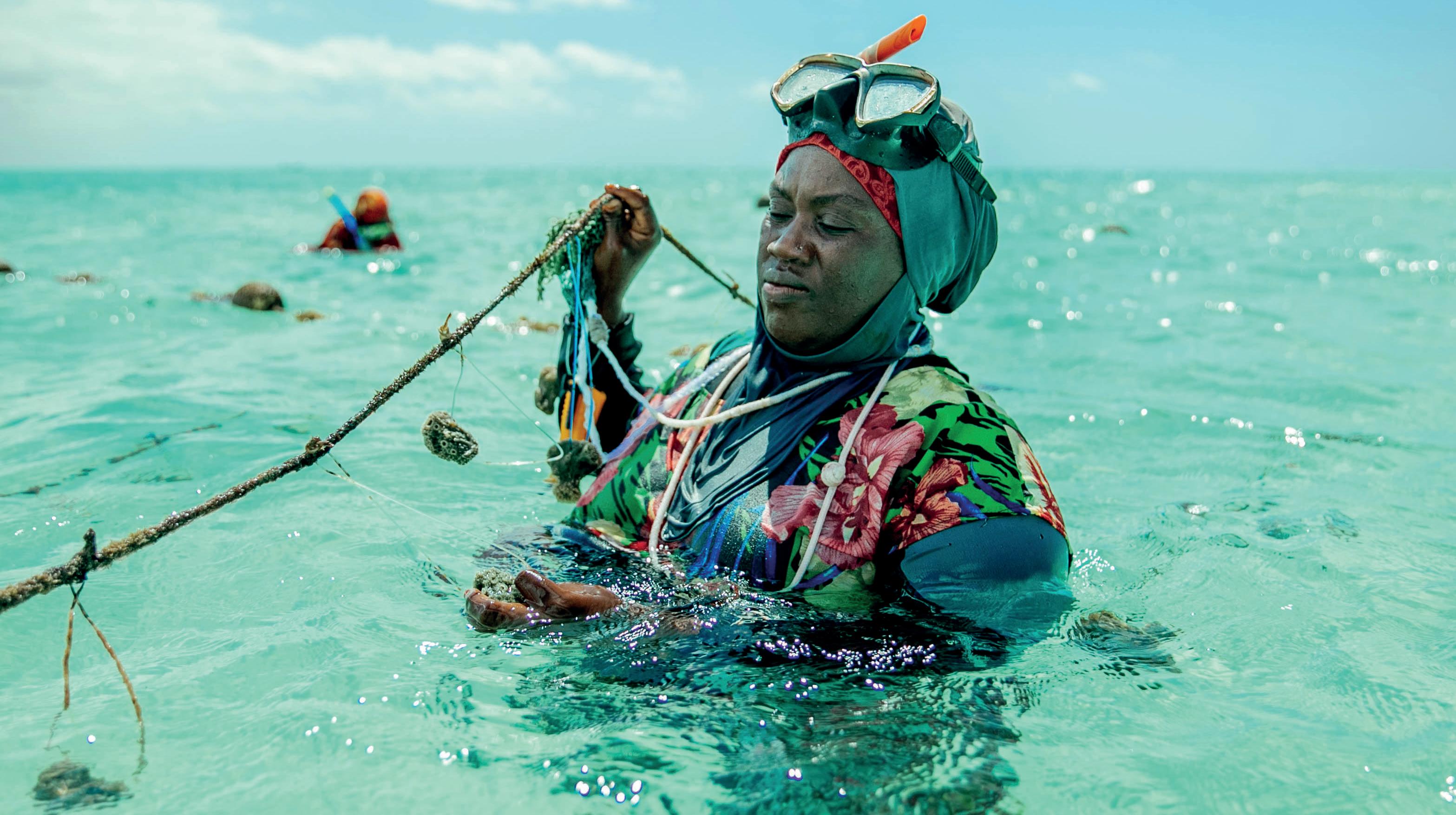
AMID THE refreshing breeze caressing Zanzibar's Jambiani coast, Hindu Rajabu wades through knee-deep water to a lagoon. Wearing swimming goggles and a snorkel perched on her headscarf, the 31-year-old mother of two cautiously navigates the Indian Ocean to locate her floating sponge farm.
Rajabu is among a handful of women in Jambiani village who in 2020 started to cultivate natural sponges. These fascinating animals are made of loosely arranged cells that surround a skeleton of fibres. The specialised cells, nestled within thousands of tiny chambers, act as microscopic pumps, tirelessly drawing water into the sponge's body with their whip-like tails. This unique pumping mechanism, which helps sponges extract nutrition and oxygen, also purifies the ocean water by removing impurities, including sewage. These sponges are also used for bathing and general hygiene because they are naturally antibacterial and antifungal and can resist odours.
With the tide gently rising, Rajabu submerges herself to reach the buoys cradling the sponge farm. Carefully, she inspects the sponges, suspended from thick polyethylene ropes. Using a knife, she removes any fouling organisms, such as bacteria and fish, which have attached themselves to the ropes. This periodic cleaning is essential to prevent the sponges from being overwhelmed by these unwanted inhabitants. The sponge farms are made of multiple ropes that run parallel to each other. They have sponges at different development stages. "We usually harvest them once a week when we collect the sponges that are big enough to be sold in the market," says Rajabu. Women typically dive deep into the ocean to collect healthy wild sponges, which serve as the foundation for their farms that are set up close to the seashore where water is up to two metres deep. These sponge colonies are then carefully cultivated and fragmented to promote new growth.
This story is from the December 16, 2023 edition of Down To Earth.
Start your 7-day Magzter GOLD free trial to access thousands of curated premium stories, and 8,500+ magazines and newspapers.
Already a subscriber ? Sign In
This story is from the December 16, 2023 edition of Down To Earth.
Start your 7-day Magzter GOLD free trial to access thousands of curated premium stories, and 8,500+ magazines and newspapers.
Already a subscriber? Sign In

INVISIBLE THREAT
Significant presence of microplastics in Puducherry’s agricultural soil raises concerns for soil and crop health

Feeding off each other
VEGETARIAN MOVEMENTS IN SOUTH ASIA AND THE WEST GREW WITH MUTUAL SUPPORT AND VALIDATION

India's unhealthy patent amendments
Despite strong pleas, the Modi regime has changed the rules to impose a cost on those who challenge faulty patents

URBAN DISCOMFORT
Poorly planned, heat-trapping infrastructure, along with dwindling natural spaces, turn up the temperatures in major Indian cities

BLAZING SUN IS ON
Rising temperatures are testing the limits of human tolerance to heat. With their predominantly built-up landscape, urban areas offer no respite. A study by the Centre for Science and Environment on the morphology and heat patterns of nine Indian cities over the past decade shows how these urban centres are turning into heat islands with a potentially serious impact on human health. An analysis by Rajneesh Sareen, Mitashi Singh and Nimish Gupta, with Shagun in Haryana and Kiran Pandey

"H5N1 may be more severe than COVID-19"
In early April, the US confirmed the first case of avian influenza in livestock, along with cow-to-human transmission of the virus disease.

A PSYCHEDELIC HIGH
Driven by surge in global trials and low success rate of current medications in treating mental health problems, researchers call for home-grown clinical trials of psychedelic drugs

Locked out
Two years after becoming the only state to be excluded from the Centre's ruralemployment guarantee scheme, villages in West Bengal grapple with distress migration and debt traps

'Protection from climate change part of right to life'
The Supreme Court of India, on April 5, recognised that citizens have a right to be free from the adverse effects of climate change, saying it is intertwined with the fundamental rights to life and equality. Here are the key arguments articulated by the three-judge bench of Chief Justice DY Chandrachud and Justices JB Pardiwala and Manoj Misra in their judgement

Weaving dreams
Tribal communities in West Bengal slowly embrace traditional weaving to ensure sustainable livelihood